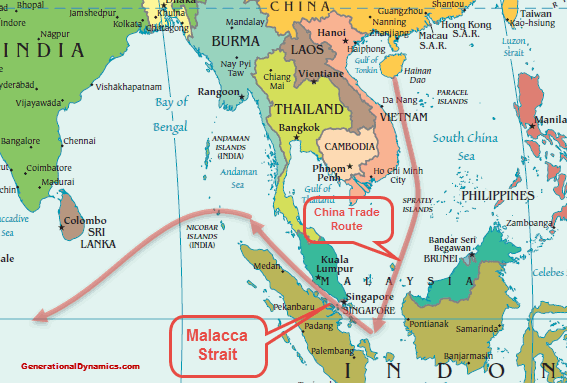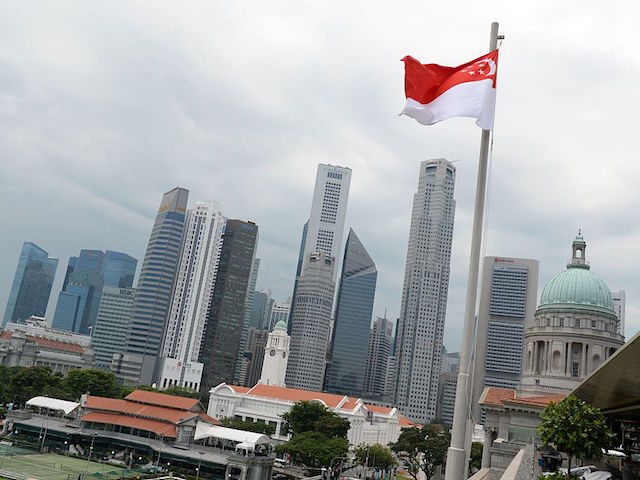This morning’s key headlines from GenerationalDynamics.com
- China’s flagrant snub of Singapore reflects deteriorating ties
- India and Singapore launch major naval exercises in South China Sea
China’s flagrant snub of Singapore reflects deteriorating ties

China commercial and military route through Malacca strait
Two weeks ago, China held its wildly spectacular One Belt One Road (OBOR) forum in Beijing. Attending were 1,200 delegates from 110 countries, including 28 heads of state. Among them were seven leaders from members of the Association of Southeast Asian Nations (ASEAN).
But one of those leaders was noticeably missing: Singapore’s Prime Minister Lee Hsien Loong. The media debated whether China was snubbing Lee, or whether Lee had chosen not to go. Finally, Singapore’s government clarified what happened: Lee was not invited. It was an official Chinese snub.
In years past, Lee Kuan Yew, the father of the current prime minister, maintained very friendly relations with China, while still retaining a strategic relationship with the United States. But this balancing act seems to have eluded the current prime minister. He’s been increasingly critical of China’s illegal militarization of the South China Sea, and he’s even joked about China during a visit to Washington.
China got revenge last December when Hong Kong customs illegally seized nine Singapore-owned armored military vehicles being shipped from Taiwan back to Singapore. Singapore finally got them back only after several months had passed, but the message was clear: China no longer considers Singapore to be a friend.
This was further emphasized at the OBOR forum not only by snubbing prime minister Lee, but also by signing billion dollar technology deals with Malaysia and Indonesia, completely bypassing Singapore. Lowy Institute (Australia) and Global Times (22-May) and South China Morning Post (Hong Kong – 3-Dec-2016) and Bloomberg (18-May) and South China Morning Post (Hong Kong – 1-Oct-2016)
India and Singapore launch major naval exercises in South China Sea
Singapore is a tiny city-state that sits at the bottom tip of the peninsula just below the western portion of Malaysia. Singapore was a British colony and became self-governing in 1959. It was supposed to remain part of Malaysia, but in 1965 it split off due to ethnic tensions and became an independent republic.
Singapore guards the entrance to the Malacca Strait, a narrow passageway through which trillions of dollars in goods travel each year. Malacca Strait is extremely important to China as a choke point on the “Maritime Silk Road” portion of OBOR. Because of Singapore’s strategic importance, it is somewhat surprising that China has bypassed Singapore, and has only signed deals with Malaysia and Indonesia.
Both India and Singapore are fearful of Chinese military attacks. China may invade Singapore as part of an effort to keep the Malacca Straits open, and India has officially expressed concern that China’s military may attack the lightly-defended Andaman and Nicobar Islands, which are India’s sovereign territory.
This week, India and Singapore are conducting major joint naval exercises called “SIMBEX,” taking place in the South China Sea. Each country is fielding numerous warships and aircraft.
According to an Indian navy spokesman:
This year’s edition of SIMBEX, the 24th such bilateral combat exercise, is aimed at further increasing interoperability between the two navies as well as developing common understanding and procedures for maritime security operations.
The thrust of the exercise, with the harbor phase scheduled from May 18 to 20 and the sea phase from May 21 to 24, will be on anti-submarine warfare, integrated operations with surface, air and sub-surface forces, air defense and surface encounter operations.
China’s Foreign Ministry commented on the exercises by warning that the activities should “not hurt the interests of other countries,” which presumably alludes to China’s illegal military bases in the South China Sea:
If such exercises and cooperation are for the benefits of regional peace and stability, then we have no opposition,” Foreign Ministry spokesperson Hua Chunying said when asked for China’s response by Indian media at a daily briefing.
We hold a very open attitude to normal exchanges between countries. We just hope when relevant countries conduct such exchange and cooperation they should bear in mind such activities not hurt the interests of other countries or have a negative impact to regional peace and stability.
It is generous of China to have an open attitude toward “normal exchanges” between countries. However, China has repeatedly threatened America’s “Freedom on Navigation” trips through the South China Sea, and has used its vast military power to prevent Vietnam and the Philippines from even accessing their own sovereign waters.
From the point of view of Generational Dynamics, the closer association between Singapore and India is significant because it puts the strategically important Singapore clearly aligned with the West.
The Independent (Singapore) and India Today and India Times
Related Articles
- India deploying ‘submarine killer’ planes to counter China’s submarines (27-Jan-2016)
- Australia / Singapore choose sides re Taiwan (23-Aug-2004)
- China launches ‘One Belt One Road’, raising objections and violent protests (14-May-2017)
KEYS: Generational Dynamics, Singapore, China, Malacca Strait, India, Lee Hsien Loong, Lee Kuan Yew, SIMBEX, One Belt One Road, OBOR
Permanent web link to this article
Receive daily World View columns by e-mail

COMMENTS
Please let us know if you're having issues with commenting.